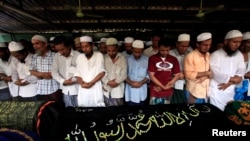BANGKOK —
A fire at a mosque in Burma's largest city, Rangoon, early Tuesday, killed at least 13 children as they were sleeping in their quarters. Officials say the fire was caused by faulty electrical wiring, but it comes just days after sectarian violence between Buddhists and Muslims in March left 43 people dead, dozens injured and thousands homeless, most of them Muslims.
Trucks of armed riot police closed off the road leading to the burned mosque in eastern Rangoon. They strung yellow tape in front of the area and stood guard.Behind the tape a couple of hundred onlookers, most of them Muslims who wanted to know what caused this tragedy.
Thant Zaw Oo, a township officer in Botahtaung, said everyone feels very sad for what happened.
He explained that early in the morning, around 2:50, the electric transformer inside the mosque became overheated and caused an electrical short that caused a fire nearby a ladder. He said, because of the incident, 13 students who were sleeping upstairs in the mosque were blocked in the fire and killed.
It is not clear why the children were trapped in the fire. Police said a few other children sleeping upstairs were able to escape along with most of the more than 70 other children living in the mosque compound.
Khin Than Soe, a Red Cross worker in Botahtaung, arrived at the scene at 3:00 am. She helped rescue 30 children from the fire.
She said a fire broke out inside the building, but she did not know exactly what happened to cause it.
Tensions building
Despite the rapid conclusion by police and officials that the fire was an accident, the deaths of children inside a mosque are likely to draw scrutiny concerns following weeks of tension between Buddhists and Muslims.
Sectarian clashes in March in central Burma left 43 people dead, most of them Muslims.
The fighting erupted after a commercial dispute between a Muslim gold shop owner and a Buddhist customer escalated into mob violence and looting.
Buddhist mobs targeted Muslim neighborhoods, burning thousands of homes and destroying a number of mosques.
The sectarian unrest spread as far south as the outskirts of Rangoon before the military and police were able to restore order.
Satellite photos released by Human Rights Watch show entire neighborhoods burned to the ground.
Burmese President Thein Sein blamed instigators for threatening the country's reforms and promised to take action against those responsible.
But Human Rights Watch deputy director for Asia, Phil Robertson, said authorities have, so far, held few accountable.
“The government and the police have been effectively silent on this," Robertson noted. "You know, it's left to the president to make a sort of a welcome speech to set the tone, but again, does this trickle down to any sort of action to protect people's lives on the ground?”
The sectarian violence echoes last year's clashes in western Rakhine state that killed close to 200 people and left 120,000 others displaced, most of them stateless Rohingya Muslims.
Trucks of armed riot police closed off the road leading to the burned mosque in eastern Rangoon. They strung yellow tape in front of the area and stood guard.Behind the tape a couple of hundred onlookers, most of them Muslims who wanted to know what caused this tragedy.
Thant Zaw Oo, a township officer in Botahtaung, said everyone feels very sad for what happened.
He explained that early in the morning, around 2:50, the electric transformer inside the mosque became overheated and caused an electrical short that caused a fire nearby a ladder. He said, because of the incident, 13 students who were sleeping upstairs in the mosque were blocked in the fire and killed.
It is not clear why the children were trapped in the fire. Police said a few other children sleeping upstairs were able to escape along with most of the more than 70 other children living in the mosque compound.
Khin Than Soe, a Red Cross worker in Botahtaung, arrived at the scene at 3:00 am. She helped rescue 30 children from the fire.
She said a fire broke out inside the building, but she did not know exactly what happened to cause it.
Tensions building
Despite the rapid conclusion by police and officials that the fire was an accident, the deaths of children inside a mosque are likely to draw scrutiny concerns following weeks of tension between Buddhists and Muslims.
Sectarian clashes in March in central Burma left 43 people dead, most of them Muslims.
The fighting erupted after a commercial dispute between a Muslim gold shop owner and a Buddhist customer escalated into mob violence and looting.
Buddhist mobs targeted Muslim neighborhoods, burning thousands of homes and destroying a number of mosques.
The sectarian unrest spread as far south as the outskirts of Rangoon before the military and police were able to restore order.
Satellite photos released by Human Rights Watch show entire neighborhoods burned to the ground.
Burmese President Thein Sein blamed instigators for threatening the country's reforms and promised to take action against those responsible.
But Human Rights Watch deputy director for Asia, Phil Robertson, said authorities have, so far, held few accountable.
“The government and the police have been effectively silent on this," Robertson noted. "You know, it's left to the president to make a sort of a welcome speech to set the tone, but again, does this trickle down to any sort of action to protect people's lives on the ground?”
The sectarian violence echoes last year's clashes in western Rakhine state that killed close to 200 people and left 120,000 others displaced, most of them stateless Rohingya Muslims.












